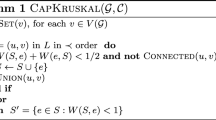Abstract
The frequency assignment problem (FAP) asks for assigning frequencies (channels) in a wireless network from the available radio spectrum to the transceivers of the network. One of the graph theoretical models of FAP is the L(3, 2, 1)-labeling of a graph, which is an abstraction of assigning integer frequencies to radio transceivers such that (i) transceivers that are one unit of distance apart receive frequencies that differ by at least three, (ii) transceivers that are two units of distance apart receive frequencies that differ by at least two, and (iii) transceivers that are three units of distance apart receive frequencies that differ by at least one. The relaxation of the L(3, 2, 1)-labeling called the (s, t, r)-relaxed k-L(3, 2, 1)-labeling is proposed in this paper. This concept is a generalization of the (s, t)-relaxed k-L(2, 1)-labeling (Lin in J Comb Optim 2016, doi:10.1007/s10878-014-9746-9). Basic properties of (s, t, r)-relaxed k-L(3, 2, 1)-labeling are discussed and optimal (s, t, r)-relaxed k-L(3, 2, 1)-labelings for paths and some cycles as well as for the hexagonal lattice and the square lattice are determined.








Similar content being viewed by others
References
Calamoneri T, Petreschi R (2004) \(L(h, 1)\)-labeling subclasses of planar graphs. J Parallel Distrib Comput 64:414–426
Chang GJ, Kuo D (1996) The \(L(2, 1)\)-labeling problem on graphs. SIAM J Discret Math 9:309–316
Chia M, Kuo D, Liao H, Yang C, Yeh RK (2011) \(L(3, 2, 1)\)-labeling of graphs. Taiwan J Math 15:2439–2457
Clipperton J, Gehrtz J, Szaniszlo Z, Torkornoo D (2006) \(L(3, 2, 1)\)-labeling of simple graphs. Valparaiso University, Verum
Dai B, Lin WW (2015) On \((s, t)\)-relaxed \(L(2, 1)\)-labelings of the triangular lattice. J Comb Optim 29:655–669. doi:10.1007/s10878-013-9615-y
Dai B, Lin W (2013) On \((s, t)\)-relaxed \(L(2, 1)\)-labelings of the square lattice. Inf Process Lett 113:704–709
Duan Z-M, Lv P-l, Miao L-Y, Miao Z-K (2010) Optimal channel assignment for wireless networks modelled as hexagonal and square grids. In: Proceedings of 2nd IEEE international conference on network security, wireless communications and trusted computing (NSWCTC), pp 85–88
Dupont A, Linhares AC, Artigues C, Feillet D, Michelon P, Vasquez M (2009) The dynamic frequency assignment problem. Eur J Oper Res 195:75–88
Griggs JR, Yeh RK (1992) Labelling graphs with a condition at distance 2. SIAM J Discret Math 5:586–595
Jia-zhuang L, Zhen-dong S (2004) The \(L(3, 2, 1)\)-labeling problem on graphs. Math Appl 17:596–602
Kim BM, Rho Y, Song BC (2015) \(L(h, k)\)-labelling for octagonal grid. Int J Comput Math 92:2243–2250
Klavžar S, Špacapan S (2006) The \({\varDelta }^2\)-conjecture for \(L(2, 1)\)-labelings is true for direct and strong products of graphs. IEEE Trans Circuits Syst II Exp Briefs 53:274–277
Kratochvíl J, Kratsch D, Liedloff M (2007) Exact algorithms for \(L(2,1)\)-labeling of Graphs, MFCS 2007. LNCS 4708:513–524
Lin W (2016) On \((s, t)\)-relaxed \(L(2, 1)\)-labeling of graphs. J Comb Optim 31:405–426. doi:10.1007/s10878-014-9746-9
LINGO 13.0 (2016) Optimization Modeling Software for Linear, Nonlinear, and Integer Programming. http://www.lindo.com/index.php?option=com_content&view=article&id=2&Itemid=10
Shao Z, Vesel A (2013) Integer linear programming model and satisfiability test reduction for distance constrained labellings of graphs: the case of \(L(3, 2, 1)\) labelling for products of paths and cycles. IET Commun 7:715–720
Shao Z, Vesel A (2015) \(L(3,2,1)\)-labeling of triangular and toroidal grids. Cent Eur J Oper Res 23:659–673
Shao Z, Zhu E, Vesel A, Xu J, Zhang X (2016) The complexity of (1,0)-relaxed \(L(2,1)\)-labeling of graphs, submitted
van den Heuvel J, Leese RA, Shepherd MA (1998) Graph labeling and radio channel assignment. J Graph Theory 29:263–283
Žerovnik J (1998) On the convergence of a randomized algorithm frequency assignment problem. Cent Eur J Oper Res Econ 6:135–151
Author information
Authors and Affiliations
Corresponding author
Additional information
This project is supported by the National Natural Science Foundation of China under Grant 61309015, the Ministry of Science of Slovenia under the Grant 0101-P-297, the National Basic Research Program of China (973 Program) Grant Nos. 2013CB329601 and 2013CB329603.
Rights and permissions
About this article
Cite this article
Shao, Z., Vesel, A. & Xu, J. Frequency assignment problem in networks with limited spectrum. Cent Eur J Oper Res 25, 699–723 (2017). https://doi.org/10.1007/s10100-016-0462-7
Published:
Issue Date:
DOI: https://doi.org/10.1007/s10100-016-0462-7




